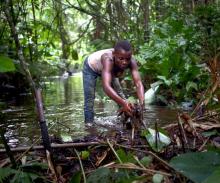Land Library
Bienvenue dans la bibliothèque du Land Portal. Explorez notre vaste collection de ressources en libre accès (plus de 74 000), comprenant des rapports, des articles scientifiques, des articles de recherche, des publications évaluées par des pairs, des documents juridiques, des vidéos et bien plus encore.
/ library resources
Showing items 1 through 9 of 2537.Depuis les années 1980, les efforts de conservation dans les pays en développement ont tenté de concilier les objectifs de la biologie de conservation et le développement social. Les approches sont multiples.
Ce 03 mai 2022, le résumé du rapport LES FORETS DU BASSIN DU CONGO - ETAT DES FORETS 2021 de l'OFAC a été présenté au XVème Congrès Forestier Mondial à Séoul.
As a result of high-density urbanization and climate change, both the frequency and intensity of extreme urban rainfall are increasing.
Countries in Southeast Asia have been developing quickly from a predominantly rural to predominantly urban society, leading to a rapid increase in urban land. This increase in urban land has mainly occurred in river deltas and floodplains, exposing humans and human assets to flood hazard.
Soil thickness (ST) plays an important role in regulating soil processes, vegetation growth and land suitability. Therefore, it has been listed as one of twelve basic soil properties to be delivered in GlobalSoilMap project.
Ecosystem Services (ESs) are bundles of natural processes and functions that are essential for human well-being, subsistence, and livelihoods. The ‘Green Revolution’ (GR) has substantial impact on the agricultural landscape and ESs in India.
As the impact of climate change on the agricultural sector has begun to manifest itself in its severity, adaptation planning has come under scrutiny for favoring the preservation of status-quo conditions over more substantial changes.
Inclusionary housing (IH) is a regulatory instrument adopted by local governments in many countries to produce affordable housing by capturing resources created through the marketplace. In order to assess whether it is efficient, scholarly attention has been widely focused on its evaluation.
Grassroots innovations, understood as bottom-up experiments on more socio-ecologically sound practices, have been a primary focus in civic-oriented studies on transformative pathways to sustainability.



